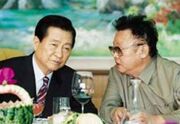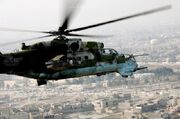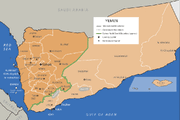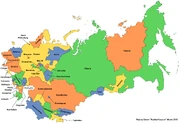| The following New Union page is under construction.
Please do not edit or alter this article in any way while this template is active. All unauthorized edits may be reverted on the admin's discretion. Propose any changes to the talk page. |
The following article contains sections which are to help explain specific events and scenarios within the New Union timeline. All sections are to be written from OTL's perspective in order to help understand minor changes which wouldn't be mentioned within the timeline itself.
Please do not add anything to this article.
Government and Politics[]
Cold War[]

American-Soviet friendship.
The Cold War was formally declared over on December 3, 1989, but many elements of which continue to be present decades later. From a cultural outlook, the Cold War ceased to exist decades ago, with Americans and Soviets continuing to be cooperative and positive towards each other. But from a diplomatic and military prospective, it could be said the Cold War still exists in many areas. Both the USSR and the USA remain the two superpowers within the world, and as such still push for superiority over the other. As of the past few decades, this has mostly been done by diplomatic and economic means within the developing world. While the threat of a nuclear war continues to exist, such a conflict continues to be unlikely to happen today (just as OTL). The use of proxy wars has also declined since the 1990s as both superpowers favor democratic governments (though more allied to to them as opposed to the other).
Soviet relations with NATO has also become more positive to the point of cooperation. The only time tensions began to flare between the two since the POD was on the potential expansion of NATO into the former Warsaw Pact (which Moscow pressured to not happen). Other than potential expansion, NATO-Soviet relations are positive.
In comparison to the West, the Sino-Soviet relations are not as friendly as OTL. Both nations have emerged as regional economic powers, and both wish to dominate the region. While Cold War tensions remain low between the two, their relations are nowhere similar to OTL.
Communism[]
Just as it's been throughout the 20th Century, the word communism continues to have varying ideologies and meanings associated with it and varies from country to country. The most notable difference from OTL would be within the Communist Party of the Soviet Union and within the USSR as a whole. By the 1990s, the CPSU was in the process of democratizing and liberalizing their policies and framework within a reformed nation. Today the party bares little resemblance to what it once was and has devolved into a mostly democratic socialist and left-wing populist party (virtually on par with many post-Cold War Communist Parties).
Outside the Soviet Union, the world communist, more or less, retains the same images as OTL. In the former Warsaw Pact (particularly within the Baltic States and the Visegrád Group) the word has become something synonymous with Nazi in many respects, harboring back to a period of occupation and oppression. Many of these nations (just as OTL) have banned the display of communist symbolism. The same can be said for the United States, which still views communism as a dirty word. In the People's Republic of China, communism continues to control the nation (though mostly in name only).
International[]
Afghanistan[]
Mikhail Gorbachev and Nikolai Ryzhkov would continue to give economic and military aid to the pro-Soviet government of Mohammad Najibullah in Afghanistan throughout the early 1990s. Najibullah was able to hold onto power prior to the collapse of the Soviet Union (OTL), so it would be safe to assume he'd continue to do so (ATL). Remaining in power, Najibullah would continue to work with the Mujahideen and others to bring an end to decades of war.
After years of negotiations, a peace plan is finalized around 1994 (brokered by Mikhail Gorbachev). Under the plan, the monarchy was to be re-established in Afghanistan. The former King of Afghanistan, Mohammed Zahir Shah, agreed to return to Afghanistan provided the people wished for him to do so (which they unanimously agreed upon in a referendum). The monarchy was to mostly become a figurehead for Afghanistan, with most of the decisions to be done under a parliamentary democracy (headed by a Prime Minister). Najibullah agreed to step down as leader of Afghanistan, with the monarchy taking affect in 1995.
Despite the unanimous support by the Mujahideen (including military leader Ahmad Shah Massoud), the more Islamist factions (headed by Gulbuddin Hekmatyar and Hezbi Islami) would continue the Civil War. This new conflict would only last a few years, as the re-established Kingdom of Afghanistan now had the backing of the citizens, much of the former Mujahideen, and even backing from the Soviet Union. Despite the end of American backing, Pakistan would continue to aid the Islamists during this time. Fighting comes to a standstill as the pro-Pakistani forces are able to hold onto the mountainous regions in southern Afghanistan. A UN-backed ceasefire take place around 1998, at which time southern Afghanistan gains de facto independence as the Islamic Republic of Pashtunistan (which is only recognized by Pakistan).
The Kingdom of Afghanistan has begun to rebuild itself since the 2000s (with international backing) and has emerged as a working democracy. Afghanistan continues to have close relations with the Soviet Union. The Islamic Republic of Pashtunistan is primarily backed by Pakistan and has been regarded as a buffer state between them and the pro-Soviet government in Kabul. Fighting within the region is centered around the de facto border between Afghanistan and Pashtunistan, with the rest of the region remaining peaceful.
The Taliban (as we know it) was never established, with elements of which likely being absorbed into Hezbi Islami. Al-Qaeda would not see the region as a potential safe haven, instead choosing to remain in Sudan.
Cuba[]

Democratic protests break out in Cuba on August 5, 1994.
With the USSR continuing to exist, Cuba would continue to work closely with their major ally. Despite the Special Period not happening, the Cuban government would have some problems. As feared, the continued cooperation with the new USSR would lead to the Cuban people wanting similar change. Finally breaking out into full protest on August 5, 1994, Cuba would not have the "luxury" to act against its people as in OTL (since fear that the USSR would stop funding, or even support the protesters, gripped Castro). Based on the possibilities of another revolution and even a potential American invasion, Fidel Castro would shock the world by announcing his resignation as President, and allowing the first free elections to take place by the following year. Within a year, Cuba would begin their own glasnost and perestroika, elect a new President and a new National Assembly. The country continues to be a prominently socialist nation, and has close relations with Nicaragua and Venezuela (not to mention the continued support by the Soviet Union). Due in part to these reforms, the United States would end their embargo on the island nation, and restart relations with their long lost neighbor.
Czechoslovakia[]
Due in part to the success of the new Soviet government, as well as the fear that Communism may retake the nation; the Czechs and Slovaks see beyond their differences, and look towards a continued future together. The "Czech and Slovak Federal Republic" (otherwise known as Czechoslovakia) continues to exist as a united nation, ironically united under a Soviet-styled federation.
Ethiopia[]
Despite being too late to prevent the collapse of the communist government and the eventual withdraw of Eritrea, the Soviets would not turn their backs on their major African ally. Gorbachev would be supportive of a Soviet-styled government between the ethnic groups of Ethiopia, leading to the formation of modern day Ethiopia. Despite the long road, Ethiopia has risen from the ruins of the 1980s, and has become a powerful nation in northern Africa.
Iraq[]
During the Gulf War (pre-POD), Mikhail Gorbachev was considered by the Americans as being "too soft" towards Iraqi dictator Saddam Hussein. Because he remains in power, and the USSR's had a history of supporting Iraq, the US foreign policy would remain anti-Saddam. Consequently when the CIA learned of a assassination plot against Hussein, it secretly supported the coup. With this backing, the plan would remain secret (unlike OTL), and would eventually become successful. Hussein was assassinated in 1995.
Despite the hopes of the Iraqis, the Kurdish rebels in northern Iraq took their chances and declared independence. Due in part to neighboring Turkey, which opposed any independent Kurd state (in fear that it would spark revolts in the Kurdish regions of its own country), no nation recognizes the independence of Kurdistan. While Civil War within Kurdistan is avoided, a bitter conflict between the breakaway nation and Baghdad would further prevent peace initiatives. The conflict intensified when the Shia-dominated south followed in Kurdistan's footsteps and declared sovereignty from Baghdad.
Backed by the United Nations, a ceasefire and peace process took place by 1999. During the peace talks, Gorbachev, now retired, proposed transforming Iraq from a unitary state into a union of sovereign states (not unlike the USSR). The idea gained strong support from the Shias, but mixed feelings from the Kurds and Sunnis. Despite this all three would eventually agree to a union. It was proposed that the Sunni-dominated "Republic of Iraq" simply become united with the two remaining regions in a new nation called the "Union of Mesopotamia". The name change gained strong support from the people, allowing to restart with a fresh slate (so to speak). A new constitution was implemented on January 1, 2001.
Korea[]

Kim Dae-jung and Kim Jong-il.
Despite the continuation of the Soviet Union as a global power, the Korean Peninsula is still divided between the Democratic People's Republic of Korea in the north Republic of Korea in the south. While not looking much different from OTL, a continued presence of the USSR in the peninsula would become a major positive for both states.
The Soviet Union would continue to give aid to North Korea, which would help mitigate the famine of the 1990s and would discourage their expansion of isolationism following the collapse of the USSR (OTL). Though China's influence over the DPRK would remain much stronger, the continued funding from the USSR would cause the North Korean regime to listen more to what Moscow is telling them (though this can only go so far). The best example would be the USSR putting pressure on the DPRK to "partially abandon" their nuclear weapons program in exchange for more Soviet aid and partial protection. Their nuclear program has not been disbanded, rather it would be purposely delayed. North Korea would remain a mystery (on par with Iran OTL).
Prior to the POD, the Soviet Union was already in the process of improving their relations with South Korea. The USSR would become a new marketplace for South Korean goods and vise versa. South Korea may also view a friendly USSR as another counterbalance against Chinese, Japanese, and even American influence in the region. Active relations would also become a counterbalance between North Korean relations within the region. Unlike OTL, the South Korean Sunshine Policy towards North Korea would be expanded and prolonged. This policy may also be [partially] adopted by the United States.
Somalia[]

Soviet helicopter over Mogadishu.
Because Al-Qaeda remained active in Sudan (instead of Afghanistan), the group would also gain support within Somalia. This is expanded in 2001 following an American-lead invasion of Sudan (in response to 9/11). By early 2003, Somalia would be invaded by Ethiopia and the Soviet Union when Al-Qaeda cells attack both nations in 2002. The regions of Puntland and Somaliland would become valued partners during the conflict.
Somalia is reorganized into a Soviet-styled federation comprised of equal and sovereign states. Despite early efforts to gain independence, Somaliland eventually agrees to remain within Somalia under the conditions of regional sovereignty. Ethiopian and Soviet troops would remain stationed in southern Somalia for almost a decade after the invasion, though both would remain vital allies for the new Somali government afterwards. The nation has slowly been recovering since the early 2000s. While piracy continues to be a threat for the area, the situation is much safer than OTL (due to an increase in the Soviet Navy within the region).
Sudan and South Sudan[]

Map of Sudan and Southern Sudan (Kush).
With Afghanistan never emerging as a potential safe haven, Al-Qaeda and Osama bin Laden would continue to reside in Sudan (which is lead by Omar al-Bashir). Following the terrorist attacks on 9/11, Sudan is invaded by the United States. Unlike Afghanistan, Sudan falls quickly and is easily occupied. Al-Bashir and bin Laden are captured and put on trial. A democratic government is established in Sudan.
Despite a new government, the regions of Southern Sudan demand independence. Since the region was not ethnically Arab, South Sudan is able to achieve independence much earlier. With the name Sudan being seen as a "negative" word (similar to Afghanistan OTL to a degree), South Sudan gains independence as the Republic of Kush. The War in Darfur never takes place as Sudan is now under the occupation of the United States.
United States[]
With the Cold War over, the United States would begin to establish good relations with the Soviet Union and many post-Communist nations. While still continuing to be rivals in the post-Cold War world, both nations generally see each other in a positive image.

The flag of the United States (note the 52 stars).
Following the end of communism in Cuba and the growing Soviet presents in the Caribbean, the 1998 referendum held in Puerto Rico comes back with a majority favoring statehood. After a period of debate, Puerto Rico is admitted into the United States in early 2000. Following which, the remaining territories of the US are reorganized. Guam and the Northern Mariana Islands are admitted as the State of Mariana around 2002 (to balance the admission of Puerto Rico), while American Samoa is reorganized into an organized commonwealth (much like what Puerto Rico once was).
The presidential election of 2000 ends with a clearer victory for Al Gore, who becomes the 43rd President of the United States. Because of which, the 2000s would be a more liberal decade for the US, though Congress would remain controlled by the Republican Party throughout the Gore administration. Following the attacks on 9/11, the United States invades Sudan (which would continue to harbor Al-Qaeda). Sudan falls quickly and Osama bin Laden is captured earlier. The Iraq War (or equivalent) never happens. Republican Rudy Giuliani wins the 2008 presidential election.
Yemen[]

North and South Yemen.
Just as in OTL, South Yemen attempts to regain independence in 1994, due to what they see as North Yemeni-dominance in the newly unified Republic of Yemen. Rather than ignore them, the Soviet Union indirectly backs their formerly communist ally. This was mostly done under the guise of supporting equality within the unified Yemen, but later changing to fully aiding the South Yemenis. With Soviet support for South Yemen, the sympathetic Saudis from OTL decide to formalize their support and also begin to aid South Yemen. The civil war ends with South Yemen regaining independence, but under limited recognition for much of the 1990s.
The Democratic Republic of Yemen (South Yemen) adopts a Soviet-styled social democracy and models itself similarly to that of the USSR and other post-communist states, using its oil wealth to help rebuild the nation. The Yemeni Socialist Party continues to hold dominance within the nation. Because the nation has a stable, democratic government, South Yemen was one of the few Arab states to not revolt during the Arab Spring.
The Republic of Yemen (North Yemen) would continue to be ruled by Ali Abdullah Saleh until he is ousted during the Arab Spring. North Yemen would also formally claim all of South Yemen until 2012, when formal relations resume. North Yemen is currently going through a civil war in which the Houthis have taken over a majority of the nation.
Former Yugoslavia[]

Map of the former Yugoslavia.
The Socialist Federal Republic of Yugoslavia still dissolves into five new nations: Bosnia and Herzegovina, Croatia, Macedonia, Slovenia, and a rump Federal Republic of Yugoslavia comprised of Montenegro and Serbia (including Kosovo).
The Bosnian War as we know it is mostly avoided when the Carrington–Cutileiro plan is ratified by all parties in 1992. While Alija Izetbegović initially signed the plan for the Bosniaks, he later retracted his support under the rumors that the United States offered him recognition if he did so. Regardless of whether this is true or not, the Soviet Union should give enough counter-pressure to prevent this from happening. Under this plan, Bosnia and Herzegovina is organized into a Swiss-like federation of ethnic cantons and a directorial executive. Though the plan is ratified, an insurgency still takes place. This "Bosnian War" would be short-lived as the insurgents would be unsupported by Croatia and the FRY.
To end the Croatian War of Independence, the Z-4 plan would be reluctantly ratified around 1995. Under the plan, the Serbian Republic of Krajina is reorganized into a slightly smaller autonomous area within Croatia. The Soviet Union should put enough pressure on both the SRK and the FRY to ratify the agreement. Because of this, Operation Storm is not carried out.
With the Soviet Union being one of their only allies, the Federal Republic of Yugoslavia is pressured to hold free elections by 1997. Montenegrin Milo Djukanovic becomes the first democratically elected President. Unlike Slobodan Milosevic of OTL, Djukanovic favors federalism and implementing many of the reforms done within the Soviet Union. Djukanovic was more willing to co-operate with Kosovo, allowing them to become an equal and sovereign republic within the FRY as opposed to gaining independence. The Kosovo War is completely avoided. Shortly after this, the regions of Sandžak and Vojvodina receive similar sovereignties.
Languages[]
- Cyrillic Alphabet — Since the Soviet Union would not dissolve, the Cyrillic alphabet would continue to be officially used for the languages which formally changed in OTL. These languages include: Azerbaijani, Chechen, Gagauz, Karakalpak, Moldovan (which is actually Romanian written in Cyrillic), Turkmen, and Uzbek.
- Karelo-Finnish Language — By today, the Karelian language is formally regarded as a dialect of Finnish. This came about due to a growing, non-Soviet population within the Republic of Karelia.
- Serbo-Croatian Language — Because the Yugoslav Wars ended with peaceful solutions for ethnic minorities across the former Yugoslavia, the Serbo-Croatian language continues to be the official languages of Bosnia and Herzegovina, Croatia, and the Federal Republic of Yugoslavia. Croats continue to use the Latin alphabet, Serbs continue to use the Cyrillic alphabet, while Bosniaks commonly use both.
Soviet Union[]

The 34 republics of the Soviet Union.
Thanks to the efforts of Gorbachev and his reforms, the Soviet Union would gradually evolve from a single-party state into a true democratic federation. Each republic of the USSR would gain greater sovereignty from Moscow, allowing for regional growth which further helps the USSR out of its 1980s-90s recession. The Soviet Union would also continue to expand its global position, cooperating with many nations (aside from ones who are compatible to the USSR [a la Cold War]). The USSR would recognize the independence of the Armenia, Estonia, Georgia, Latvia, Lithuania, and Moldova by 1992. Despite hopes for positive relations, war will break out between the USSR and its former republics of Georgia and Moldova over disputed regions. By late 1992, the break-away regions of Abkhazia, Gagauzia, South Ossetia, and Pridnestrovie (Transnistria) would be secured and willingly merged into the USSR. With the continuation of the "Parade of Sovereignties," many more autonomous regions within the USSR would demand (and eventually receive) full republican status.
Chechnya and Ingushetia[]
Without the August Coup against Mikhail Gorbachev, Dzhokhar Dudayev and the All-National Congress of the Chechen People would not see the need to remove the pro-Soviet government of Chechnya. As it becomes clearer what kind of nation the Soviet Union was to become, much of the pro-independence factions within Chechnya begin to look towards compromise. Given the potential for conflict within the region, the USSR would favor reorganizing Chechnya into a sovereign republic within the Soviet federation. Because of this, the Republic of Ingushetia is never established (whose sole purpose was to remain within Russia while Chechnya moved towards independence).
Within a few years following the POD, the Checheno-Ingush ASSR is reorganized into the Vainakh Republic within the Soviet Union. With the Chechens gaining equality and sovereignty, the First and Second Chechen Wars would never take place (thereby butterflying away the broader Insurgency in the North Caucasus). Without these conflicts against Russia, Islamic fundamentalism would not take hold within the region and today would remain mostly secular.
Crimea and Ukraine[]
With the Ukraine remaining in the Soviet Union, the overall divide which exists within the republic (OTL) would gradually decline as an issue. Ethnic Russians and Russian-speaking Ukrainians would have more linguistic equality within the Ukraine, while the more ethnically Ukrainian peoples in the west would have more regional sovereignty then during the Cold War. With the Soviet economy improving since the 1980s, the Ukraine (as a whole) would also be more economically secure (causing these divides to become more insignificant by today). The Orange Revolution, the 2014 Revolution, and the pro-Russian conflict within Eastern Ukraine don't happen.
Because both Russia and the Ukraine remain part of a single nation, the Russian majority of the Crimea would see no reason to go against the Ukraine. A sovereignty movement does take place during the 1990s, but this would not result in any bad feelings for the region. Without the collapse of the USSR, the Crimean Tatars would now make up a lager amount of the population than OTL. The city of Sevastopol would not be a part of the Crimea and instead would be a federal city within the USSR (comparable to OTL).
Space[]

The Buran program is successful in this timeline.
- Soviet space program: In 1993, the space program of the USSR was organized into a NASA-like entity known as the SAKA. The Baikonur Cosmodrome continues to act as the primary spaceport for the USSR. The city of Baikonur has become something like the "Cocoa Beach of the Soviet Union," with the city growing in size in only a few years.
- Buran Program: Instead of canceling the program, the citizens and scientists of the Soviet Union would show more interests in the Buran program (primarily as a means to get civilians active and to bring a new light to the old age of Soyuz. By 1995, both the United States and the Soviet Union have working shuttle programs.
- International Space Station: Despite the fact that there are now two shuttle programs, the ISS would not be built. With a better Soviet economy and optimism, the idea of combining Mir-2 and Freedom into the ISS would not be thought of as likely. Instead, both stations would become their own, run by their respective governments. Despite there not being cooperation on a single space station by the USA and USSR, there is still a cooperation between the two nations. "Soviet astronauts" have served on Freedom, while "American cosmonauts" have served on on Mir-2.
- Soviet Moonshot and Extraterrestrial: Announced in 2005, the Soviet space program has begun work for a Soviet Moonshot and beyond. The USSR announces that the Moonshot program will begin in 2012, with a Moon landing as early as 2015. Despite the Americans wanting to win this "second space race," the American Constellations Program is set for a Moon landing as early as 2020.
| |||||||||||||||||
